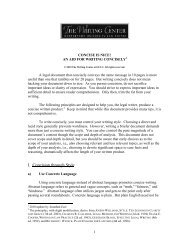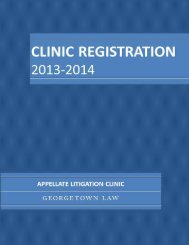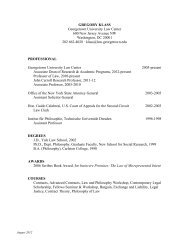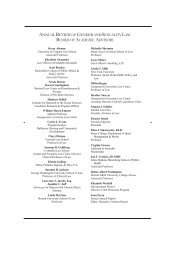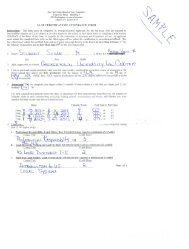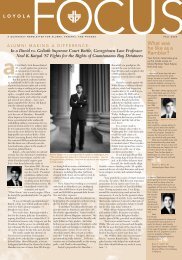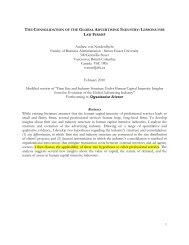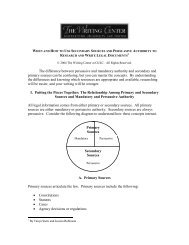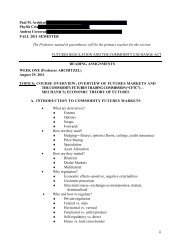Date: April 12, 2013 Topic: The Shrinking ... - Georgetown Law
Date: April 12, 2013 Topic: The Shrinking ... - Georgetown Law
Date: April 12, 2013 Topic: The Shrinking ... - Georgetown Law
You also want an ePaper? Increase the reach of your titles
YUMPU automatically turns print PDFs into web optimized ePapers that Google loves.
<strong>The</strong> introduction of a new technology into an organization can change the way<br />
individuals work and how they learn from each other. Technologies such as information systems<br />
and knowledge databases open up access to knowledge that was previously unavailable to<br />
organizational members (Lucas 1975; Zuboff 1988), and can thus disrupt an established social<br />
structure (Leonardi 2007). When knowledge is systematically stored and disseminated using<br />
technology, organizational transparency can increase as people use technology to find where a<br />
specific bit of knowledge resides. Technology, therefore, may reduce the need to rely on<br />
personal relationships or social capital for knowledge search in the workplace. Further,<br />
knowledge that is discovered or located through technology might also more easily be used<br />
directly by others without forming any relationship to the creator of that knowledge.<br />
Although in general technology can clearly reduce human labor and increase efficiency,<br />
several scholars have suggested that technology has important limitations in its application to<br />
knowledge management (e.g., Alavi and Leidner 2001). In particular, technology may not<br />
effectively replace individuals’ social capital when performing knowledge work. Because<br />
knowledge is locally embedded in people and their relationships, social capital (i.e. relationships)<br />
is critical to accessing and transferring knowledge (Tsai, 2001). Complex knowledge is<br />
especially difficult to codify for systematic reuse and dissemination, and people may still have to<br />
rely on their prior social relationships to access and comprehend such complex knowledge<br />
(Hansen 1999).<br />
Prior research on knowledge sharing inside organizations has tended to focus on either<br />
technology use, or on workplace social relationships (e.g. Reagans & McEvily, 2003), essentially<br />
viewing them as separate phenomena. Few studies have examined technology use and<br />
relationship dynamics simultaneously, or distinguished their relative influence (Haas and Hansen,<br />
2007). In this paper, we investigate the tension between technology use and relationships, and we<br />
also show how they may complement each other to create value. Specifically, we ask: How does<br />
technology use compare with prior social capital as the basis for forming new workplace<br />
relationships and creating value?<br />
To address this question, we analyze both qualitative and quantitative data collected from<br />
a large European law firm concerning its implementation of a new technology: a knowledge<br />
management system (KMS) designed to capture, store, and disseminate knowledge in lawyers’<br />
work. We use interview data and meeting records to describe our research context and the KMS<br />
implementation processes and to inform our theory development. In our quantitative analysis, we<br />
use records of KMS document downloads, client billings, and personnel information to examine<br />
the dynamic interplay between technology use and social capital. We examine how the interplay<br />
of those two factors shapes the formation of new workplace relationships among organizational<br />
members and the creation of value through billable-hours revenue generation.<br />
<strong>The</strong> use of KMS’s for managing professional knowledge work has increased rapidly. A<br />
recent report shows that Am<strong>Law</strong> 200 firms invest on average $5-7 million per year in KMS<br />
technology (Cohen 2011). Typically, investments in KMS technologies in professional service<br />
firms are aimed at leveraging the intellectual capital of organizational members and facilitating<br />
transfer of knowledge among them. Yet although the KMS technology is expected to help<br />
management of knowledge work by identifying best practices and keeping track of employees’<br />
knowledge, whether such technology actually creates value for employees has not been proven in<br />
the existing literature. In addition, prior research has not systematically examined the<br />
consequences of using such technology for workplace relationships. In this research, we observe<br />
<br />
2



